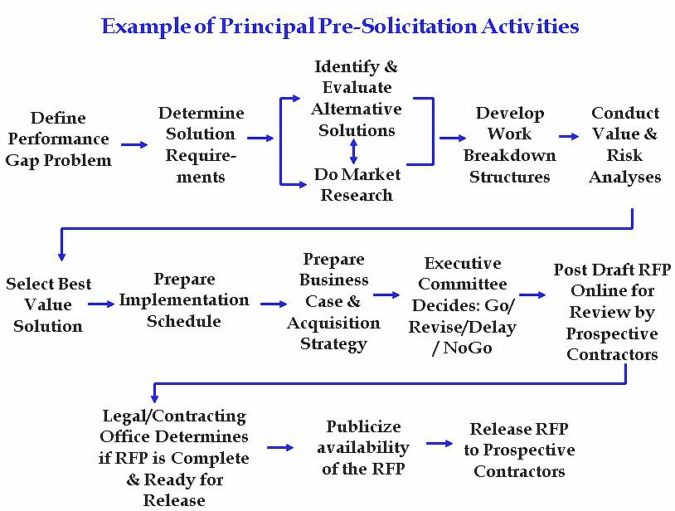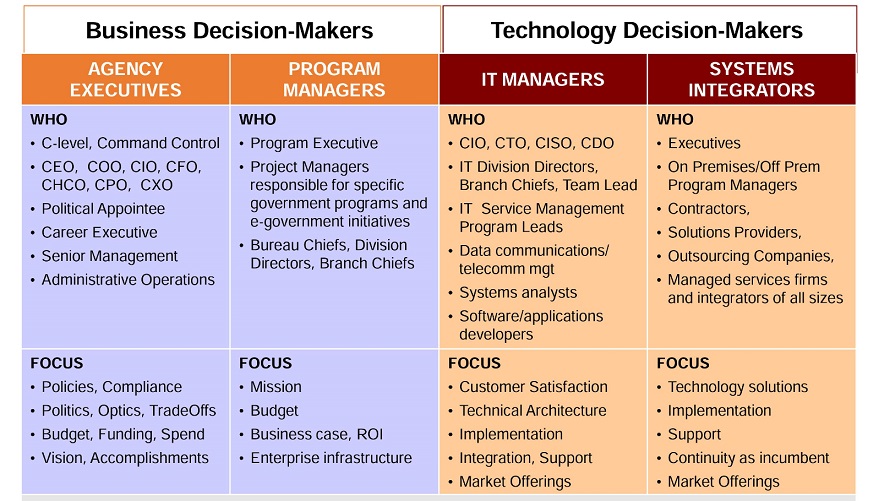If you market to the government market, you know what a complicated process it can be. It’s often a challenge to know exactly which government decision makers within the agency to communicate with, and to know exactly what those decision makers are looking for from a contractor partner.
I recently attended a government marketing event that focused precisely on this challenge. It was the recent GAIN 2016 conference, put on by the Government Marketing University. There was a fascinating panel with four senior level federal executives sharing their perspectives on what kind of information they value, and how that information should be delivered by vendors.
The panel consisted of:
Kimberly Hancher, former CIO at EEOC and GMarkU Ambassador
Karen Britton, former Special Assistant to the President, CIO at the Executive Office of the President
Kathleen Turco, former SES CFO and GMarkU Ambassador
Martha Dorris, former Deputy Administrator, Office of Citizen Services and Innovative Technologies, GSA
The first thing the panel stressed was that a solicitation should be viewed as a journey, not an objective. Vendors should be thinking two years in advance for large contracts. The panel shared the graphic below to explain how pre-solicitation activities are processed internally:
Supporting the point about planning two years out, Kathleen talked about how the 2018 budget has already been delivered. She advised the contractors in the audience to track federal funding, not just track contracts. The money is there for IT projects, especially when there is internal coordination:
“The challenge for the agency CFO is understanding where the CIO is trying to go. There is great support for funding IT, when there is a strategic plan that clearly ties to mission delivery. And there are funding options – annual, two year, working capital fund or a franchise fund. But the internal communication between CFO and CIO is critical.”
Martha encouraged vendors to challenge themselves on the differentiation front. How are you truly different, and do your customers become ambassadors for you? She also looked for IT partners who could show some empathy for the challenges government professionals often face.
And when a company secured a meeting, they needed to come in prepared:
“When a company came in to talk to me, I wanted them to show they understood my environment and my specific problem. Don’t waste my time. And the other thing I wanted to see was, how were they solving this problem for other government clients? How did they improve service, save the agency money, etc.? I value quantifiable examples.”
Karen counseled to be reasonable with your meeting goals. It’s often best to begin at the PM level, and demonstrate how you can deliver some of the attractive savings moving from legacy infrastructure to the cloud. Know your abilities, because she always wanted options:
“At the WH I had to move fast, and I was able to do so because my CFO understood our IT path forward. We were also not afraid to reach out to vendors, to bring them in for technical presentations. By doing so they knew we had a clear vision, and they also knew we were encouraging real competition for our contracts.”
Kimberly suggested the earlier the interaction between business and government, the better for IT solutions. She cautioned contractors that a prospect is far from monolithic. There are multiple decision-makers within an agency, and each one has different pain points and priorities that must be addressed.
This slide gives an idea of these players, on both the business and technology sides within an agency:
Kimberly also had some very strong advice for incumbents facing recompetes:
“Don’t take incumbency for granted – your client doesn’t love you as much as you think they do. Don’t hit your client with too much FUD – fear, uncertainty and doubt. You are not the only game in town. Don’t let costs and salaries creep up to the point where it creates openings for competitors – keep costs down for your government clients. And finally, don’t simply rehash old case study and customer success stories from the past. Make sure you’re also talking about the future, how you are going to innovate and improve.”
The federal IT market is huge, but it is very competitive and no longer growing every year. Knowing how to best to target your time and resources as a contractor is vital. It was time well spent for me to attend this GMU event and hear from government decision makers themselves on how best to pursue federal IT contracts.

